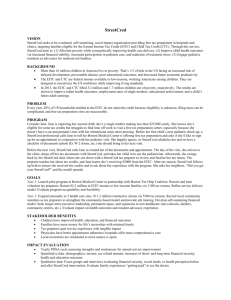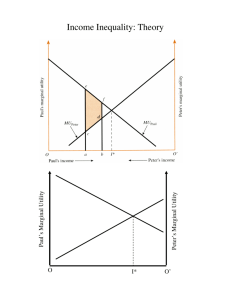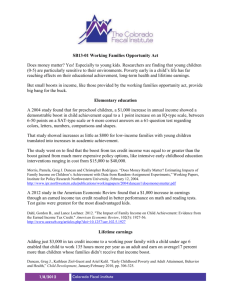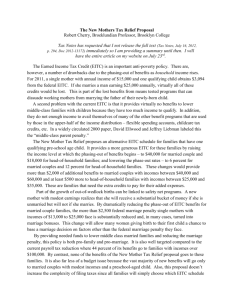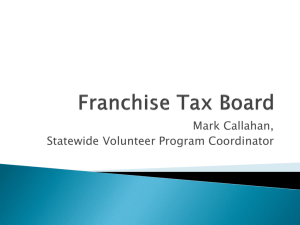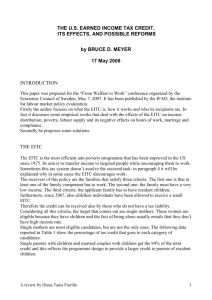Taxation and poverty: 1960–2006 The early years: 1960–1974
advertisement
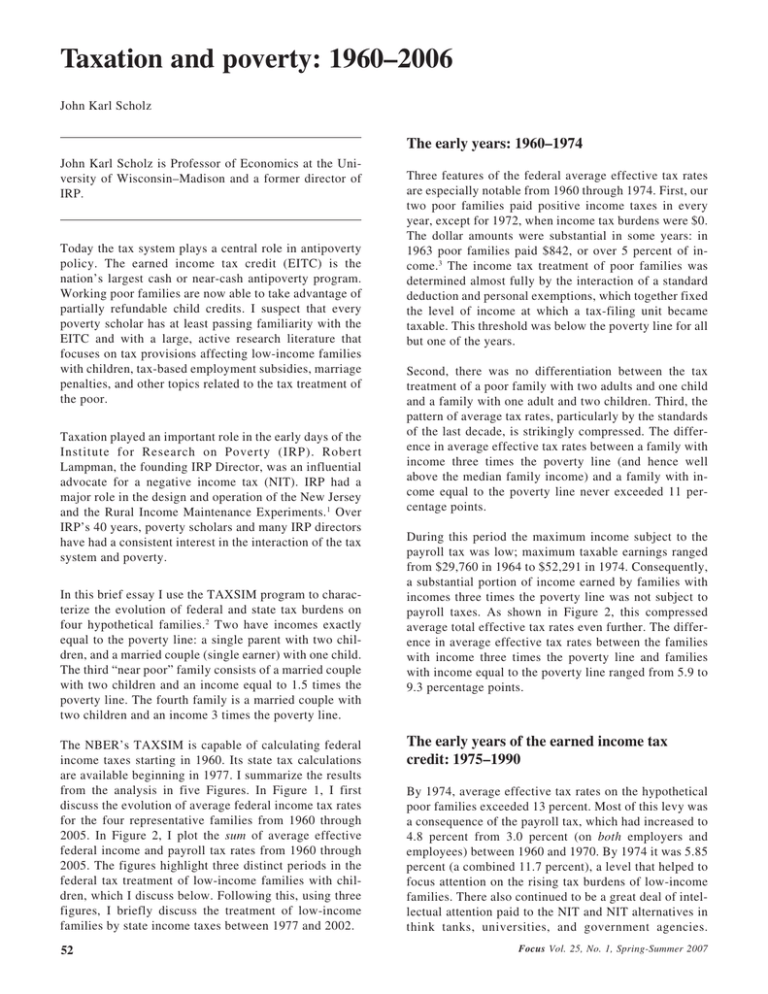
Taxation and poverty: 1960–2006 John Karl Scholz The early years: 1960–1974 John Karl Scholz is Professor of Economics at the University of Wisconsin–Madison and a former director of IRP. Today the tax system plays a central role in antipoverty policy. The earned income tax credit (EITC) is the nation’s largest cash or near-cash antipoverty program. Working poor families are now able to take advantage of partially refundable child credits. I suspect that every poverty scholar has at least passing familiarity with the EITC and with a large, active research literature that focuses on tax provisions affecting low-income families with children, tax-based employment subsidies, marriage penalties, and other topics related to the tax treatment of the poor. Taxation played an important role in the early days of the Institute for Research on Poverty (IRP). Robert Lampman, the founding IRP Director, was an influential advocate for a negative income tax (NIT). IRP had a major role in the design and operation of the New Jersey and the Rural Income Maintenance Experiments.1 Over IRP’s 40 years, poverty scholars and many IRP directors have had a consistent interest in the interaction of the tax system and poverty. In this brief essay I use the TAXSIM program to characterize the evolution of federal and state tax burdens on four hypothetical families.2 Two have incomes exactly equal to the poverty line: a single parent with two children, and a married couple (single earner) with one child. The third “near poor” family consists of a married couple with two children and an income equal to 1.5 times the poverty line. The fourth family is a married couple with two children and an income 3 times the poverty line. The NBER’s TAXSIM is capable of calculating federal income taxes starting in 1960. Its state tax calculations are available beginning in 1977. I summarize the results from the analysis in five Figures. In Figure 1, I first discuss the evolution of average federal income tax rates for the four representative families from 1960 through 2005. In Figure 2, I plot the sum of average effective federal income and payroll tax rates from 1960 through 2005. The figures highlight three distinct periods in the federal tax treatment of low-income families with children, which I discuss below. Following this, using three figures, I briefly discuss the treatment of low-income families by state income taxes between 1977 and 2002. 52 Three features of the federal average effective tax rates are especially notable from 1960 through 1974. First, our two poor families paid positive income taxes in every year, except for 1972, when income tax burdens were $0. The dollar amounts were substantial in some years: in 1963 poor families paid $842, or over 5 percent of income.3 The income tax treatment of poor families was determined almost fully by the interaction of a standard deduction and personal exemptions, which together fixed the level of income at which a tax-filing unit became taxable. This threshold was below the poverty line for all but one of the years. Second, there was no differentiation between the tax treatment of a poor family with two adults and one child and a family with one adult and two children. Third, the pattern of average tax rates, particularly by the standards of the last decade, is strikingly compressed. The difference in average effective tax rates between a family with income three times the poverty line (and hence well above the median family income) and a family with income equal to the poverty line never exceeded 11 percentage points. During this period the maximum income subject to the payroll tax was low; maximum taxable earnings ranged from $29,760 in 1964 to $52,291 in 1974. Consequently, a substantial portion of income earned by families with incomes three times the poverty line was not subject to payroll taxes. As shown in Figure 2, this compressed average total effective tax rates even further. The difference in average effective tax rates between the families with income three times the poverty line and families with income equal to the poverty line ranged from 5.9 to 9.3 percentage points. The early years of the earned income tax credit: 1975–1990 By 1974, average effective tax rates on the hypothetical poor families exceeded 13 percent. Most of this levy was a consequence of the payroll tax, which had increased to 4.8 percent from 3.0 percent (on both employers and employees) between 1960 and 1970. By 1974 it was 5.85 percent (a combined 11.7 percent), a level that helped to focus attention on the rising tax burdens of low-income families. There also continued to be a great deal of intellectual attention paid to the NIT and NIT alternatives in think tanks, universities, and government agencies. Focus Vol. 25, No. 1, Spring-Summer 2007 3HUFHQWDJHRI,QFRPH 6LQJOH3DUHQW7ZR&KLOGUHQ,QFRPHDWWKH3RYHUW\/LQH 0DUULHG&RXSOH7ZR&KLOGUHQ,QFRPH(TXDOWR7LPHVWKH3RYHUW\/LQH 0DUULHG&RXSOH7ZR&KLOGUHQ,QFRPH(TXDOWR7LPHVWKH3RYHUW\/LQH 0DUULHG&RXSOH2QH&KLOG,QFRPHDWWKH3RYHUW\/LQH Figure 1. Average federal individual income rates, 1960–2006. Source: Calculated by the author using the NBER TAXSIM program. 3HUFHQWDJHRI,QFRPH 6LQJOH3DUHQW7ZR&KLOGUHQ,QFRPHDWWKH3RYHUW\/LQH 0DUULHG&RXSOH7ZR&KLOGUHQ,QFRPH(TXDOWR7LPHVWKH3RYHUW\/LQH 0DUULHG&RXSOH7ZR&KLOGUHQ,QFRPH(TXDOWR7LPHVWKH3RYHUW\/LQH 0DUULHG&RXSOH2QH&KLOG,QFRPHDWWKH3RYHUW\/LQH Figure 2. Average total tax rate: Federal income tax plus payroll tax, 1960–2006. Source: Calculated by the author using the NBER TAXSIM program. 53 When a recession started in 1974, Congress substantially cut taxes and enacted a temporary EITC, a policy championed by Senate Finance Committee Chairman Russell Long. The maximum available credit was substantial, equaling $1,452, and the credit was to be in place for 18 months. The EITC was made permanent in 1978. Between 1978 and the Tax Reform Act of 1986 (TRA86), neither the tax credit nor the tax code were indexed for inflation, which caused a substantial erosion of the EITC’s real value. The effect of the EITC on average effective income tax rates, coupled with the failure to index exemptions, the standard deduction, and tax brackets for inflation is clear from Figure 1. Average effective rates for families with incomes at the poverty line fell sharply in 1975 with the implementation of the EITC, only to rise to their 1974 level by 1986. Payroll tax rates continued to increase; they rose from 11.7 percentage points in 1974 to 14.3 percentage points in 1986, making effective average tax rates on poor families with one adult and two children 15.3 percent, close to the highest level of taxation seen over this 45-year period. If the establishment of the EITC in 1975 was the first landmark piece of legislation affecting taxation of poor families with children, TRA86 was the second. Policymakers made an explicit decision to eliminate federal income taxes on families with incomes below the poverty line. They further increased the EITC to the point where the maximum credit in 1987 equaled the real value of the credit in 1975. TRA86 also indexed for inflation the EITC, exemptions, the standard deduction, and brackets. Consequently, effective tax rates in 1988 (when TRA86 was fully phased in) were similar to their level in 1975, though slightly higher because of payroll taxes. Tax policy as “making work pay” antipoverty policy: 1991–2005 The TRA86 restored the EITC to its initial value (in real dollars) and indexed the tax system so that inflation alone would no longer push families into higher tax brackets. The tax legislation in 1990 marked the beginning of the third important set of developments in the taxation of poor families, though in some cases the policy changes were not explicitly motivated by antipoverty policy. In 1990 President George H. W. Bush agreed to abandon his “no new taxes” pledge and meet with Democratic leaders of Congress to enact deficit-reduction legislation. The EITC was considered to be a straightforward way to alter the distributional characteristics of the deficit-reduction package; this, in turn, was a critical factor behind the 1990 EITC expansion that was phased in over the next three years. 54 Another major change to the EITC occurred as part of the 1993 budget bill. President Clinton in his first State of the Union address had made a promise that full-time work at the minimum wage plus the EITC (and any food stamps for which a family was eligible) would be enough to raise the family’s income, net of the payroll tax, above the poverty line. To achieve this goal, the EITC was increased, particularly for families with two or more children. By 1997, the maximum EITC had increased to $4,450; it was now $3,000 higher than its level in 1975. A oneadult, two-child family with a poverty-line income would have paid $2,068 in payroll and income taxes in 1974 and $2,398 in 1986; by 1997 the same family would receive a $1,790 refundable credit. Put differently, if the adult was working in a job with poverty-line wages (and filing a tax return), the family would have $4,000 more in disposable income in 1997 than it did in 1986. This, along with the behavioral incentives embodied in the individual income tax, is the sense in which tax policy is now a vital component of antipoverty policy. The gap in effective tax rates between families with incomes at the poverty line and those with incomes three times the poverty line is now roughly 36 percentage points. As recently as 1986, it was 12.1 percentage points. By using the tax system as a tool for antipoverty policy, government varies substantially the tax treatment of families at different points in the income distribution. The most recent major development affecting the taxation of poor families with children was the adoption in 2001 of a partially refundable child tax credit. The child credit was made refundable in an amount equal to 10 percent of earnings in excess of $10,000 (indexed for inflation), up to the maximum credit per child; the refundability percentage rose from 10 percent to 15 percent in 2005. The combination of the child credit (for upper-income families) and the partially refundable portion of that credit (for poor and near-poor families) accounts for the most recent reductions in effective tax rates shown in Figures 1 and 2. State tax changes: 1977–2002 State income tax liabilities were considerably lower than federal tax liabilities for much of the period we can examine (again, making use of the NBER’s Internet TAXSIM), but in some states they are still substantial. In other states, they provide large subsidies. Figure 3 is a time-series graph of real state tax liabilities for a oneadult, two-child family with an income equal to the poverty line. The top line shows the state in which liability at that point in time was highest. In 2002, for example, this family would have paid $439 in Alabama.4 The same family in Minnesota would have received a $2,490 state $. 07 25 3$ 25 .< 3$ 25 .< 3$ .< $/ 'ROODUV 10 :, 01 :, 01 :, 97 +, 97 01 01 0LQLPXP 0D[LPXP 3RSXODWLRQ:HLJKWHG$YJHUDJH Figure 3. State income tax liability for a family of one adult and two children, with a poverty-line income, 1977–2002. Source: Calculated by the author using the NBER TAXSIM program. tax refund, shown in the bottom line. The populationweighted average payment is -$162; the negative value reflects, in part, the many large states that have no state individual income tax. Figures 4 and 5 examine how liabilities changed between 1977 and 2002. Figure 4 shows states that impose positive tax liabilities on our hypothetical one-adult, twochild poor family in 2002, and Figure 5 shows states that impose negative tax liabilities on this family in 2002. As mentioned earlier, Alabama in 2002 imposed the highest taxes on this poor family, although it was not a high-tax state in 1977. Most of the states taxing poor families are in the South or Midwest, though Montana and Oregon also impose substantial taxes. The states that give subsidies to the hypothetical poor family tend to be on the East Coast, in New England, or in the Upper Midwest, though Kansas is included in the large subsidy states. Mirroring the patterns observed at the federal level, the differential tax treatment of poor families in the high- and the low-tax states sharply diverged over time. In 1977, the average effective tax rate in the 5 highest-tax states was 1.4 percent. In the 5 lowest-tax states, it was -1.5 percent, for a high-to-low difference of 2.9 percentage points. By the same calculations in 2002, the 5 highest-tax states have an average effective tax rate of 2.0 percent and the 5 lowest-tax states have an average of -8.6 percent, for a high-to-low difference of 10.6 percentage points. To summarize, state income taxes add a considerable amount of variation to the overall tax burdens on poor families. The most interesting recent developments have arisen from state use of refundable credits to sharply reduce tax liabilities of poor families. The future There is tremendous uncertainty surrounding any forecast of future tax policy developments. But I suspect a few factors will continue to shape the evolution of tax policy as it affects poor families and individuals. First, the safety net has evolved to sharply emphasize employment as a requirement for public assistance and as the socially approved route to self-sufficiency. Taxation plays a central role in labor markets, since it affects the after-tax return to work. Consequently, I anticipate that employment subsidies, whether through the existing EITC, a unified child and employment credit, or through wage subsidies, will be a fixture of tax policy as it affects low-income households. 55 'ROODUV 8 WD K W9 LUJ LQ LD HV : KL R 2 UH JR Q 2 $O DE DP D $U ND QV DV * HR UJ LD + DZ DL L ,OO LQ RL V ,Q GL DQ D .H QW XF N\ /R XL VL DQ D 0 LV VL VV LS SL 0 LV VR XU L 0 RQ 1 W D RU QD WK & DU RO LQ D Figure 4. States with a positive tax liability for a family of one adult and two children, with a poverty-line income, 2002. Source: Calculated by the author using the NBER TAXSIM program. 'ROODUV 9H UP RQ W : LV FR QV LQ DQ 0 LQ QH VR WD 1 HZ HU VH \ 1 HZ 0 H[ LF R 1 HZ < RU N 2 NO DK RP D HW WV KL J 0 LF G FK XV 0 DV VD DV R 0 DU \O DQ .D QV ,G DK ' & Figure 5. States with a negative tax liability for a family of one adult and two children, with a poverty-line income, 2002. Source: Calculated by the author using the NBER TAXSIM program. 56 Second, budget deficits and EITC noncompliance will place pressure on employment subsidies implemented through the tax code. The source of the budget pressure is clear: the federal government is currently running large budget deficits. The growth rate of health-related entitlements and the impending retirement of the baby boom generation will put additional pressure on budgets. Although a large literature finds consistent, positive employment effects from the EITC, a significant fraction of its payments appear to go to taxpayers who are not eligible for the credit.5 The most recent study of EITC noncompliance (for tax year 1999) found that of the $31.3 billion claimed in EITC payments, between $8.5 and $9.9 billion, or 27.0–31.7 percent of the total, exceeded the amount for which taxpayers were eligible. Of these errors, the most common problem was that EITCqualifying children failed to live for at least six months with the taxpayer claiming the child. Tax returns do not collect information on the location of children during the year. Absent additional information, therefore, the IRS has little ability to scrutinize EITC qualifying-child claims before the EITC is paid out. The combination of budget pressure and noncompliance may limit the EITC’s role in antipoverty policy in the future. 3 All dollar amounts referred to in the paper are in 2005 dollars, unless noted otherwise. 4 In Figure 3, unlabeled points, if labeled, would have the label of the previously listed state. So, for example, Pennsylvania has the maximum state tax liability of $309 in 1979 (in 2005 dollars). Pennsylvania has the maximum levy in 1980 (of $344). This does not change until 1982, when Oregon has the highest state tax liability ($378). 5 See e.g. V. J. Hotz and J. K. Scholz, “The Earned Income Tax Credit,” in Means-Tested Transfer Programs in the United States, R. Moffitt, ed., The University of Chicago Press and NBER, 2003, 141– 197. Finally, the employment problems of low-skilled, childless individuals are severe. Poor labor market prospects (and outcomes) contribute, I believe, to crime and its associated incarceration costs and to unstable families, so that large fractions of poor children are being raised in single-parent households. Yet very few tax or spending incentives are targeted toward childless individuals. I think the logic and evidence are compelling that increasing the after-tax return to work for low-skilled, childless individuals will increase employment. With increased employment we would expect to see reductions in crime and incarceration, and more numerous and more stable marriages. Hence, I expect new developments in tax policy to focus, at least to some extent, on low-wage, childless individuals. 1 Lampman’s role in developing the negative income tax is beautifully described by Robert Moffitt in his 2004 Lampman Memorial Lecture. See the adaptation for Focus: R. A. Moffitt, “The Idea of a Negative Income Tax: Past, Present, and Future,” Focus 23, no. 2 (Summer 2004): 1–3. 2 This is the Internet tax simulation program developed by Daniel Feenberg and colleagues at the National Bureau of Economic Research. See D. R. Feenberg and E. Coutts, “An Introduction to the TAXSIM Model,” Journal of Policy Analysis and Management 12, no. 1 (Winter 1993): 189–94, and http://www.nber.org/taxsim/ for information on the model. We assume all families were renters and paid 25 percent of their income toward rent. 57


